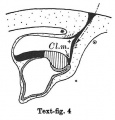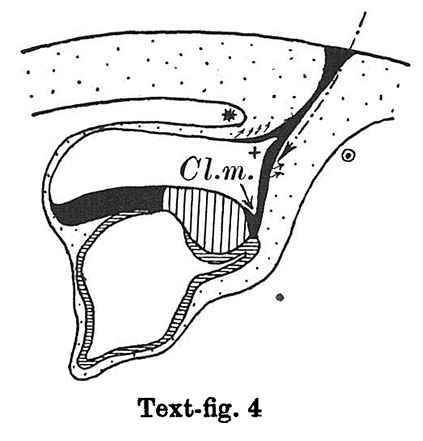File:Florian1930-text-fig04.jpg
Florian1930-text-fig04.jpg (423 × 441 pixels, file size: 31 KB, MIME type: image/jpeg)
Text-fig 4. Schemes of the chief stages in the development of the human embryo
In stage 4, represented by the embryo Bi I, of which a schema is shown in text-fig. 4, the bending of the axis of the stalk has become more distinct, and its tip forms a sharper angle with the embryonic plate than in the preceding stage. In text-fig.4 I have shown an amniotic duct connecting the amniotic ectoderm with the chorionic ectoderm, because two human embryos (BiI, Florian, 1927 and Strahl-Beneke, 1910) belonging to this stage possess it. It is not certain whether it is only a chance that the amniotic duct is not present in the embryos represented by text-figs. 1-3. The knot which represented the primitive streak primordium in the preceding two stages has now become transformed into a true "streak," at the end of which there is a distinct "end-knot of the primitive streak." The thickened end-knot produces a ventral down-bulging of the underlying wall of the yolk-sac and so a diverticulum is produced, at the caudal end of which the cloacal membrane is situated. This diverticulum resembles an allantoic outgrowth-with which, however, it has nothing to do, because it disappears during the later development by opening out into the yolk-sac cavity (Florian-Volker, 1929).
Ectoderm black; entoderm lined horizontally, primitive streak vertically, head process and chorda plate obliquely. Mesoderm dotted. The axis of the connecting stalk is marked by an arrow. The limits of the connecting stalk are marked by * and ʘ, the limits of the umbilical stalk by + and ʘ). The direction of the extension of the amniotic cavity towards the connecting stalk is marked by arrows. The parts of the allantois and of the axis of the connecting stalk situated out of the median plane are finely dotted. A. Connecting stalk; B. umbilical stalk; Cl.m. cloacal membrane.
| Historic Disclaimer - information about historic embryology pages |
|---|
| Pages where the terms "Historic" (textbooks, papers, people, recommendations) appear on this site, and sections within pages where this disclaimer appears, indicate that the content and scientific understanding are specific to the time of publication. This means that while some scientific descriptions are still accurate, the terminology and interpretation of the developmental mechanisms reflect the understanding at the time of original publication and those of the preceding periods, these terms, interpretations and recommendations may not reflect our current scientific understanding. (More? Embryology History | Historic Embryology Papers) |
- Links: Text-fig 1 | Text-fig 2 | Text-fig 3 | Text-fig 4 | Text-fig 5 | Text-fig 6 | Text-fig 7 | Text-fig 1-7 | Text-fig 8 | Text-fig 9 | Text-fig 8-9 | Florian 1930 | Historic Embryology Papers
Reference
Florian J. The formation of the connecting stalk and the extension of the amniotic cavity towards the tissue of the connecting stalk in young human embryos. (1930) J. Anat., 64: 454-476.
Cite this page: Hill, M.A. (2024, April 27) Embryology Florian1930-text-fig04.jpg. Retrieved from https://embryology.med.unsw.edu.au/embryology/index.php/File:Florian1930-text-fig04.jpg
- © Dr Mark Hill 2024, UNSW Embryology ISBN: 978 0 7334 2609 4 - UNSW CRICOS Provider Code No. 00098G
File history
Click on a date/time to view the file as it appeared at that time.
| Date/Time | Thumbnail | Dimensions | User | Comment | |
|---|---|---|---|---|---|
| current | 18:58, 23 September 2015 |  | 423 × 441 (31 KB) | Z8600021 (talk | contribs) |
You cannot overwrite this file.
File usage
The following 3 pages use this file:

